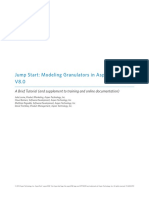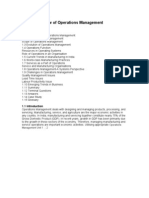Professional Documents
Culture Documents
Flex Sensor Based Wireless Robot
Copyright
Available Formats
Share this document
Did you find this document useful?
Is this content inappropriate?
Report this DocumentCopyright:
Available Formats
Flex Sensor Based Wireless Robot
Copyright:
Available Formats
Volume 2, Issue 7, July 2017 International Journal of Innovative Science and Research Technology
ISSN No: - 2456 2165
Flex Sensor Based Wireless Robot
Glove Controlled Robot
Rishabh Mahesh Jitender Kumar Singh
Student Assistant Professor
Department of Mechanical Engineering Department of Mechanical Engineering
Shobhit University Shobhit University
Meerut, India Meerut, India
rishabhdixit25@yahoo.in jitendra@shobhituniversity.ac.in
Abstract A wired glove is an input device for human II. RELATED WORK
computer interaction worn like a glove. Sensors play an
important role in the field of robotics as they help to
An exciting description of inertial sensors and some
determine the current state of the system. Various sensor
innovative application of sensors have been explained in
technologies are used to capture physical data such as
[1]. [2] gives an examination of the impact of individual
bending of fingers. Robotic applications demand sensors
sensor on the performance of a navigation system. [5]
with high degrees of repeatability, precision, and
gives the design of a controller which is capable of
reliability. The pick and place operation of robotic arm
controlling an anthropomorphic robotic arm through a
can be efficiently controlled using flex sensors and micro
LAN or via the Internet. [6] provides a review of relevant
controller programming. This work is based on the
mobile robot positioning technologies like Odometry,
educational concepts of mechanical engineering and
Inertial Navigation, Magnetic Com-passes, GPS Model
electronics engineering.
Matching etc. Pick and place operation by controlling the
speed and position using FPGA has been discussed in [7].
KeywordsFlex sensor; Accelerometer; Microcontroller; But the important contribution of present work is that any
Transmitter; Resistance. human arm moments can be mapped onto the robotic arm
with good precision. Further the flexibility of micro
controller programming makes the task easier.
I. INTRODUCTION
III. PROJECT DESCRIPTION
The concept of a data glove has been traditionally accepted in A. Transmitter
the field of engineering. Engineers continue to develop
prototypes that use innovative sensor technologies and
architectures to achieve the goal of gesture identification. The
combination of medical science and engineering has made the
task like difficult surgery by robotic arm simpler. To identify
the motion of human limbs, different sensors can be used.
Many companies have designed units, which can integrate
accelerometers, gyroscopes and can be attached to human
limbs. These units can be worn for video game character
modeling [1], virtual reality [2,3], activity recognition [4]. A
sensor is a device that can measure some attribute of motion,
being one of the three primitives of robotics (besides planning
and control), sensing plays an important role in robotic
paradigms. Robotic arm manipulators can have different
configurations and kinematic constraints. Few of these
constraints can be effectively mapped from the human arm
domain to the robots restricted joint space. In this paper a
general method of mapping human motions to the robotic arm
domain has been demonstrated. The arm moment is
reciprocated almost exactly by the robotic arm. The author has
designed a robot which is controlled wirelessly with the help
of hand gestures which rather than controlling it manually
through a conventional remote controller. The Robot moves
and acts in the manner depending on the gestures made by the
fingers and hand from a distance. Fig. 1 Block Diagram of Transmitter Unit
IJISRT17JL182 www.ijisrt.com 438
Volume 2, Issue 7, July 2017 International Journal of Innovative Science and Research Technology
ISSN No: - 2456 2165
Above figure shows the general block diagram of the C. Design Flow
transmitter unit of the robot. Flex sensor and accelerometer are
interfaced with microcontroller. Output devices are LCD
display and RF transmitter unit of CC2500.
B. Receiver
Fig. 3 Basic flow diagram of transmitter
Fig. 2 Block Diagram of Receiver Unit
The receiver part of RF module receives transmitted signals in
synchronization. These incoming signals are analog in nature.
These are converted into digital in microcontroller itself.
Instructions are processed and output signals are provided to
motor driver, by the output of which the motor actions take
place.LM293 motor driver provides 12V signal to boost in
speed whereas only controlling is done by controllers 5V
supply. Both units are powered by 12V regulated supply.
ATMEGA 16 is major intelligent part of the whole assembly
Alongside a display is used to display the status of the robot. Fig. 4 Basic Flow Diagram of Receiver
IJISRT17JL182 www.ijisrt.com 439
Volume 2, Issue 7, July 2017 International Journal of Innovative Science and Research Technology
ISSN No: - 2456 2165
IV. HARDWARE IMPLEMENTATION C. Accelerometer
A. Microcontroller
Fig. 5 Physical View of ATMEGA16 Fig. 7 Accelerometer Chip
ATmega16 is an 8-bit high performance microcontroller of
Atmels Mega AVR family with low power consumption. The ADXL335 is a small, thin, low power, complete 3 -axis
Atmega16 is based on enhanced RISC (Reduced Instruction Set accelerometer with signal conditioned voltage outputs. The
Computing) architecture with 131 powerful instructions. Most product measures acceleration with a minimum full-scale
of the instructions execute in one machine cycle. Atmega16 can range of 3 g. It can measure the static acceleration of gravity
work on a maximum frequency of 16MHz. in tilt-sensing applications, as well as dynamic acceleration
resulting from motion, shock, or vibration. The bandwidth of
the accelerometer can be selected by using the CX, CY, and
B. Flex Sensors CZ capacitors at the X-OUT, Y-OUT, and Z-OUT pins.
Bandwidths can be selected within a range of 0.5 Hz to 1600
Hz for the X axis and Y axis, and a range of 0.5 Hz to 550 Hz
Flex sensors are analog resistors. These resistors work as a for the Z axis.
variable analog voltage divider. Within the flex sensor, carbon
resistive elements are present with a very thin flexible
D. RF Module
substrate. More quantity of carbon results in less resistance.
When the substrate is bent the sensor produces resistance
output according to the bend radius. Great form factor is
achieved by the flex sensor on a thin flexible substrate. As the
substrate is bent, resistance output is produced by the sensor
according to the bend radius as shown in Figure 6.
Fig. 6 Flex Sensor Bend Proportional to Varying Degree of
Resistance. Fig. 8 Cc2500 Module
IJISRT17JL182 www.ijisrt.com 440
Volume 2, Issue 7, July 2017 International Journal of Innovative Science and Research Technology
ISSN No: - 2456 2165
[7]. U. D. Meshram and R. Harkare, FPGA Based Five Axis
E. Applications Robot Arm Controller, International Journal of
Electron-ics Engineering, Vol.2, No.1, 2010, pp. 209-211.
Collection of data [8]. Jagdish Lal Raheja, Radhey Shyam, Umesh Kumar,
Wireless metering Bhanu Prasad, Real-Time Robotic Hand Control using
Remote control / Remote measurement system Hand Gestures, Second International Conference on
Multi slave communication Machine Learning and Computin,2010.
Access control
V. CONCLUSION
In this project, we aimed to build an automated robot which
works on the gesture moments. It is a wireless communicating
device. Unlike other remote controlled robot, this design is
more efficient in the range of use and security. The objective
of preparing these projects is to understand the different kind
of sensor available and interface them with smartest
microcontroller. Also it has been beneficial to understand the
concepts of programming of controller. More outcomes from
the project are to learn PCB designing, etching, soldering,
assembling processes employed in any project design.
VI. ACKNOWLEDGMENT
We gratefully acknowledge the guidance of Mr. Raj Kishore
Singh, Asst. Professor, Department of Mechanical
Engineering, Shobhit University, Meerut who was the
constant source of inspiration and guidance to us. Also, we
would like to thank him for granting us permission to use
various instruments in department laboratory.
REFERENCES
[1]. Slyper and J. Hodgins, Action Capture with Accel-
erometers, Euro Graphics/A CMSIG GRAPHS Sympo-
sium on Computer Animation, 2008.
[2]. E. Foxl and L. Naimark, Vis-Tracker: A Wearable Vi-
sion-Inertial Self-Tracker, IEEE Virtual Reality Confer-
ence, 22-26 March 2003, Los Angeles.
[3]. M. Gross and D. James, Eurographics/ACM SIGGRAPH
Symposium on Computer Animation, Smart Objects
Con-ference SOC 03, Grenoble,2003.
[4]. L. Bio and S. Intille, Activity Recognition from User-
An-notated Acceleration Data, Pervasive Computing,
Vol. 3001, 2004, pp. 1-17. doi:10.1007/978-3-540-24646-
6_1.
[5]. D. Fontaine, D. David and Y. Caritu, Sourceless Human
Body Motion Capture, Smart Objects Conference (SOC
2003), Grenoble, 2003.
[6]. J. Bernstein, H. R. Everett, L. Feng, and D. Wehe, Mo-
bile Robot Positioning Sensors & Techniques, Journal of
Robotic Systems, Special Issue on Mobile Robots, Vol. 14,
No. 4, pp. 231-249.
IJISRT17JL182 www.ijisrt.com 441
You might also like
- A Curious Case of QuadriplegiaDocument4 pagesA Curious Case of QuadriplegiaInternational Journal of Innovative Science and Research TechnologyNo ratings yet
- Analysis of Financial Ratios that Relate to Market Value of Listed Companies that have Announced the Results of their Sustainable Stock Assessment, SET ESG Ratings 2023Document10 pagesAnalysis of Financial Ratios that Relate to Market Value of Listed Companies that have Announced the Results of their Sustainable Stock Assessment, SET ESG Ratings 2023International Journal of Innovative Science and Research TechnologyNo ratings yet
- Adoption of International Public Sector Accounting Standards and Quality of Financial Reporting in National Government Agricultural Sector Entities, KenyaDocument12 pagesAdoption of International Public Sector Accounting Standards and Quality of Financial Reporting in National Government Agricultural Sector Entities, KenyaInternational Journal of Innovative Science and Research TechnologyNo ratings yet
- Food habits and food inflation in the US and India; An experience in Covid-19 pandemicDocument3 pagesFood habits and food inflation in the US and India; An experience in Covid-19 pandemicInternational Journal of Innovative Science and Research TechnologyNo ratings yet
- The Students’ Assessment of Family Influences on their Academic MotivationDocument8 pagesThe Students’ Assessment of Family Influences on their Academic MotivationInternational Journal of Innovative Science and Research Technology100% (1)
- Pdf to Voice by Using Deep LearningDocument5 pagesPdf to Voice by Using Deep LearningInternational Journal of Innovative Science and Research TechnologyNo ratings yet
- Fruit of the Pomegranate (Punica granatum) Plant: Nutrients, Phytochemical Composition and Antioxidant Activity of Fresh and Dried FruitsDocument6 pagesFruit of the Pomegranate (Punica granatum) Plant: Nutrients, Phytochemical Composition and Antioxidant Activity of Fresh and Dried FruitsInternational Journal of Innovative Science and Research TechnologyNo ratings yet
- Forensic Evidence Management Using Blockchain TechnologyDocument6 pagesForensic Evidence Management Using Blockchain TechnologyInternational Journal of Innovative Science and Research TechnologyNo ratings yet
- Improvement Functional Capacity In Adult After Percutaneous ASD ClosureDocument7 pagesImprovement Functional Capacity In Adult After Percutaneous ASD ClosureInternational Journal of Innovative Science and Research TechnologyNo ratings yet
- Machine Learning and Big Data Analytics for Precision Cardiac RiskStratification and Heart DiseasesDocument6 pagesMachine Learning and Big Data Analytics for Precision Cardiac RiskStratification and Heart DiseasesInternational Journal of Innovative Science and Research TechnologyNo ratings yet
- Optimization of Process Parameters for Turning Operation on D3 Die SteelDocument4 pagesOptimization of Process Parameters for Turning Operation on D3 Die SteelInternational Journal of Innovative Science and Research TechnologyNo ratings yet
- Scrolls, Likes, and Filters: The New Age Factor Causing Body Image IssuesDocument6 pagesScrolls, Likes, and Filters: The New Age Factor Causing Body Image IssuesInternational Journal of Innovative Science and Research TechnologyNo ratings yet
- The Experiences of Non-PE Teachers in Teaching First Aid and Emergency Response: A Phenomenological StudyDocument89 pagesThe Experiences of Non-PE Teachers in Teaching First Aid and Emergency Response: A Phenomenological StudyInternational Journal of Innovative Science and Research TechnologyNo ratings yet
- Design and Implementation of Homemade Food Delivery Mobile Application Using Flutter-FlowDocument7 pagesDesign and Implementation of Homemade Food Delivery Mobile Application Using Flutter-FlowInternational Journal of Innovative Science and Research TechnologyNo ratings yet
- Severe Residual Pulmonary Stenosis after Surgical Repair of Tetralogy of Fallot: What’s Our Next Strategy?Document11 pagesSevere Residual Pulmonary Stenosis after Surgical Repair of Tetralogy of Fallot: What’s Our Next Strategy?International Journal of Innovative Science and Research TechnologyNo ratings yet
- Comparison of Lateral Cephalograms with Photographs for Assessing Anterior Malar Prominence in Maharashtrian PopulationDocument8 pagesComparison of Lateral Cephalograms with Photographs for Assessing Anterior Malar Prominence in Maharashtrian PopulationInternational Journal of Innovative Science and Research TechnologyNo ratings yet
- Late Presentation of Pulmonary Hypertension Crisis Concurrent with Atrial Arrhythmia after Atrial Septal Defect Device ClosureDocument12 pagesLate Presentation of Pulmonary Hypertension Crisis Concurrent with Atrial Arrhythmia after Atrial Septal Defect Device ClosureInternational Journal of Innovative Science and Research TechnologyNo ratings yet
- Blockchain-Enabled Security Solutions for Medical Device Integrity and Provenance in Cloud EnvironmentsDocument13 pagesBlockchain-Enabled Security Solutions for Medical Device Integrity and Provenance in Cloud EnvironmentsInternational Journal of Innovative Science and Research TechnologyNo ratings yet
- A Review on Process Parameter Optimization in Material Extrusion Additive Manufacturing using ThermoplasticDocument4 pagesA Review on Process Parameter Optimization in Material Extrusion Additive Manufacturing using ThermoplasticInternational Journal of Innovative Science and Research TechnologyNo ratings yet
- Enhancing Biometric Attendance Systems for Educational InstitutionsDocument7 pagesEnhancing Biometric Attendance Systems for Educational InstitutionsInternational Journal of Innovative Science and Research TechnologyNo ratings yet
- Quality By Plan Approach-To Explanatory Strategy ApprovalDocument4 pagesQuality By Plan Approach-To Explanatory Strategy ApprovalInternational Journal of Innovative Science and Research TechnologyNo ratings yet
- Design and Development of Controller for Electric VehicleDocument4 pagesDesign and Development of Controller for Electric VehicleInternational Journal of Innovative Science and Research TechnologyNo ratings yet
- Targeted Drug Delivery through the Synthesis of Magnetite Nanoparticle by Co-Precipitation Method and Creating a Silica Coating on itDocument6 pagesTargeted Drug Delivery through the Synthesis of Magnetite Nanoparticle by Co-Precipitation Method and Creating a Silica Coating on itInternational Journal of Innovative Science and Research TechnologyNo ratings yet
- Investigating the Impact of the Central Agricultural Research Institute's (CARI) Agricultural Extension Services on the Productivity and Livelihoods of Farmers in Bong County, Liberia, from 2013 to 2017Document12 pagesInvestigating the Impact of the Central Agricultural Research Institute's (CARI) Agricultural Extension Services on the Productivity and Livelihoods of Farmers in Bong County, Liberia, from 2013 to 2017International Journal of Innovative Science and Research TechnologyNo ratings yet
- Databricks- Data Intelligence Platform for Advanced Data ArchitectureDocument5 pagesDatabricks- Data Intelligence Platform for Advanced Data ArchitectureInternational Journal of Innovative Science and Research TechnologyNo ratings yet
- Digital Pathways to Empowerment: Unraveling Women's Journeys in Atmanirbhar Bharat through ICT - A Qualitative ExplorationDocument7 pagesDigital Pathways to Empowerment: Unraveling Women's Journeys in Atmanirbhar Bharat through ICT - A Qualitative ExplorationInternational Journal of Innovative Science and Research TechnologyNo ratings yet
- Anxiety, Stress and Depression in Overseas Medical Students and its Associated Factors: A Descriptive Cross-Sectional Study at Jalalabad State University, Jalalabad, KyrgyzstanDocument7 pagesAnxiety, Stress and Depression in Overseas Medical Students and its Associated Factors: A Descriptive Cross-Sectional Study at Jalalabad State University, Jalalabad, KyrgyzstanInternational Journal of Innovative Science and Research Technology90% (10)
- Gardening Business System Using CNN – With Plant Recognition FeatureDocument4 pagesGardening Business System Using CNN – With Plant Recognition FeatureInternational Journal of Innovative Science and Research TechnologyNo ratings yet
- Optimizing Sound Quality and Immersion of a Proposed Cinema in Victoria Island, NigeriaDocument4 pagesOptimizing Sound Quality and Immersion of a Proposed Cinema in Victoria Island, NigeriaInternational Journal of Innovative Science and Research TechnologyNo ratings yet
- Development of a Local Government Service Delivery Framework in Zambia: A Case of the Lusaka City Council, Ndola City Council and Kafue Town Council Roads and Storm Drain DepartmentDocument13 pagesDevelopment of a Local Government Service Delivery Framework in Zambia: A Case of the Lusaka City Council, Ndola City Council and Kafue Town Council Roads and Storm Drain DepartmentInternational Journal of Innovative Science and Research TechnologyNo ratings yet
- The Subtle Art of Not Giving a F*ck: A Counterintuitive Approach to Living a Good LifeFrom EverandThe Subtle Art of Not Giving a F*ck: A Counterintuitive Approach to Living a Good LifeRating: 4 out of 5 stars4/5 (5784)
- The Yellow House: A Memoir (2019 National Book Award Winner)From EverandThe Yellow House: A Memoir (2019 National Book Award Winner)Rating: 4 out of 5 stars4/5 (98)
- Never Split the Difference: Negotiating As If Your Life Depended On ItFrom EverandNever Split the Difference: Negotiating As If Your Life Depended On ItRating: 4.5 out of 5 stars4.5/5 (838)
- Shoe Dog: A Memoir by the Creator of NikeFrom EverandShoe Dog: A Memoir by the Creator of NikeRating: 4.5 out of 5 stars4.5/5 (537)
- The Emperor of All Maladies: A Biography of CancerFrom EverandThe Emperor of All Maladies: A Biography of CancerRating: 4.5 out of 5 stars4.5/5 (271)
- Hidden Figures: The American Dream and the Untold Story of the Black Women Mathematicians Who Helped Win the Space RaceFrom EverandHidden Figures: The American Dream and the Untold Story of the Black Women Mathematicians Who Helped Win the Space RaceRating: 4 out of 5 stars4/5 (890)
- The Little Book of Hygge: Danish Secrets to Happy LivingFrom EverandThe Little Book of Hygge: Danish Secrets to Happy LivingRating: 3.5 out of 5 stars3.5/5 (399)
- Team of Rivals: The Political Genius of Abraham LincolnFrom EverandTeam of Rivals: The Political Genius of Abraham LincolnRating: 4.5 out of 5 stars4.5/5 (234)
- Grit: The Power of Passion and PerseveranceFrom EverandGrit: The Power of Passion and PerseveranceRating: 4 out of 5 stars4/5 (587)
- Devil in the Grove: Thurgood Marshall, the Groveland Boys, and the Dawn of a New AmericaFrom EverandDevil in the Grove: Thurgood Marshall, the Groveland Boys, and the Dawn of a New AmericaRating: 4.5 out of 5 stars4.5/5 (265)
- A Heartbreaking Work Of Staggering Genius: A Memoir Based on a True StoryFrom EverandA Heartbreaking Work Of Staggering Genius: A Memoir Based on a True StoryRating: 3.5 out of 5 stars3.5/5 (231)
- On Fire: The (Burning) Case for a Green New DealFrom EverandOn Fire: The (Burning) Case for a Green New DealRating: 4 out of 5 stars4/5 (72)
- Elon Musk: Tesla, SpaceX, and the Quest for a Fantastic FutureFrom EverandElon Musk: Tesla, SpaceX, and the Quest for a Fantastic FutureRating: 4.5 out of 5 stars4.5/5 (474)
- The Hard Thing About Hard Things: Building a Business When There Are No Easy AnswersFrom EverandThe Hard Thing About Hard Things: Building a Business When There Are No Easy AnswersRating: 4.5 out of 5 stars4.5/5 (344)
- The Unwinding: An Inner History of the New AmericaFrom EverandThe Unwinding: An Inner History of the New AmericaRating: 4 out of 5 stars4/5 (45)
- The World Is Flat 3.0: A Brief History of the Twenty-first CenturyFrom EverandThe World Is Flat 3.0: A Brief History of the Twenty-first CenturyRating: 3.5 out of 5 stars3.5/5 (2219)
- The Gifts of Imperfection: Let Go of Who You Think You're Supposed to Be and Embrace Who You AreFrom EverandThe Gifts of Imperfection: Let Go of Who You Think You're Supposed to Be and Embrace Who You AreRating: 4 out of 5 stars4/5 (1090)
- The Sympathizer: A Novel (Pulitzer Prize for Fiction)From EverandThe Sympathizer: A Novel (Pulitzer Prize for Fiction)Rating: 4.5 out of 5 stars4.5/5 (119)
- Her Body and Other Parties: StoriesFrom EverandHer Body and Other Parties: StoriesRating: 4 out of 5 stars4/5 (821)
- MeasurIT Tideflex & Series40 Application Flow 0806Document1 pageMeasurIT Tideflex & Series40 Application Flow 0806cwiejkowskaNo ratings yet
- 1.2.SAP Bill of Materials (BOM) - Free SAP PP TrainingDocument24 pages1.2.SAP Bill of Materials (BOM) - Free SAP PP TrainingManickath Mani NairNo ratings yet
- Automotive Tapered Roller and Ball Bearing Price ListDocument8 pagesAutomotive Tapered Roller and Ball Bearing Price ListAvijitSinharoyNo ratings yet
- Traffic Rules and FineDocument8 pagesTraffic Rules and FineNarayan VermaNo ratings yet
- ME / M.Tech-Mechanical 2017-2018: Sno Projects List Design AnalysisDocument5 pagesME / M.Tech-Mechanical 2017-2018: Sno Projects List Design AnalysisSanjay ShelarNo ratings yet
- Rig Workover Operations PDFDocument45 pagesRig Workover Operations PDFKhaled 2006No ratings yet
- Condenser & Heater PerformanceDocument116 pagesCondenser & Heater PerformanceGaurav Singh100% (2)
- Instant Dfs System PDFDocument4 pagesInstant Dfs System PDFMithilesh KumarNo ratings yet
- Modern ArchitectureDocument14 pagesModern ArchitectureAnonymous Y9dgyXhANo ratings yet
- LS H NPT 3KDocument2 pagesLS H NPT 3KBenjaz AvilaNo ratings yet
- Structural Design of Surge TankDocument3 pagesStructural Design of Surge TankSudan ShakyaNo ratings yet
- Grid Slab or Waffle SlabDocument2 pagesGrid Slab or Waffle Slabjncame33% (3)
- Aggregate Impact ValueDocument8 pagesAggregate Impact ValueAnis Nurfarahanim Abdul HalimNo ratings yet
- 04 PDFDocument146 pages04 PDFEli RochaNo ratings yet
- Dse3110 User InstructionsDocument13 pagesDse3110 User InstructionsJohn Garnet100% (2)
- Marlin WS LQDocument2 pagesMarlin WS LQVictor PileggiNo ratings yet
- Formation Evaluation Through Core AnalysisDocument80 pagesFormation Evaluation Through Core AnalysisjardelbrunoNo ratings yet
- EN 10210-1 - 2006 - Table 2 PDFDocument1 pageEN 10210-1 - 2006 - Table 2 PDFvimal_mech123No ratings yet
- Pavement HardDocument3 pagesPavement HardJus CamungaoNo ratings yet
- Moss Inert Gas GeneratorDocument4 pagesMoss Inert Gas GeneratorIan Bronkhurst100% (2)
- MortarDocument12 pagesMortarshahidul islamNo ratings yet
- 2 - Introduction To The ME Engine PDFDocument14 pages2 - Introduction To The ME Engine PDFVikash Khaliyav Yadav50% (2)
- Lesson AGMA Standard - Example 1 & 2Document23 pagesLesson AGMA Standard - Example 1 & 2Sphumelele SibuthaNo ratings yet
- A Seminar Presentation On: "5G Wireless Technnology"Document20 pagesA Seminar Presentation On: "5G Wireless Technnology"Rahul prabhaNo ratings yet
- GRanulatorDocument14 pagesGRanulatormigelNo ratings yet
- Bulk Carriers (A Detailed Synopsis) : Maritime TradeDocument8 pagesBulk Carriers (A Detailed Synopsis) : Maritime TradeAnonymous UCveMQNo ratings yet
- LG 15.0-inch LCD Monitor Service ManualDocument37 pagesLG 15.0-inch LCD Monitor Service ManualRobert GreenNo ratings yet
- Operations ManagementDocument175 pagesOperations ManagementAnurag Saikia100% (2)
- Oaj Issue2 Kazan FinalDocument9 pagesOaj Issue2 Kazan FinalfcordNo ratings yet
- Vaghodia Compressor STNDocument41 pagesVaghodia Compressor STNAyaanNo ratings yet




































































































